All photographs by Nell Farrell while living in San Felipe del Agua, Oaxaca, Mexico. See project statement.
When I went to ask Father Salvador about Día de la Candelaria, he invited me to a blessing of the cross to take place on the same day in the hills above the bus terminal. The photographs and observations below are from these two events.
La Candelaria
Groundhog Day, Candlemas, a sacred day in the Aztec calendar and the beginning of the agricultural cycle, the midpoint between the solstice and the equinox, forty days after the birth of Christ: Día de la Candelaria, February 2nd.
It is difficult to discuss La Candelaria without looking back to Christmas and the Epiphany (Día de los Reyes, January 6th). Traditionally, forty days after a baby’s birth—February 2nd if he was born on December 25th—his mother takes him out for the first time. Thus it is on this day that Mexican Catholics bring the baby Jesus from their own nativities to be blessed at church. Also, earlier, on Día de los Reyes, many families ate a symbolic sweet bread into which was embedded a tiny figure of baby Jesus: If he’s in your piece, you are to supply the tamales for La Candelaria. The corn of the masa, of which the tamale is made, is a direct link between the ancient observance and the contemporary, for all that corn meant to the Aztecs and still signifies in Mexico today.
It was a Sunday, and I arrived before mass to find lines of people hugging the shady edges of the churchyard, waiting for the priest to bless the baby Jesus each had brought. There was logistical confusion as the church ladies organized everyone into two rows. The priest emerged and spoke briefly through a microphone, then walked down the lines sprinkling holy water on everyone before the crowd moved into the church for the service.
The baby Jesuses were light-or dark-skinned, dressed in pajamas or with gold crowns, life-sized or miniature. Most were cradled in the crooks of arms, their plastic halos endlessly slipping, others held absentmindedly, but all easier to handle than the real babies, who were heavy in the hot sun, squirming, and with bottles, sun hats and siblings to juggle.
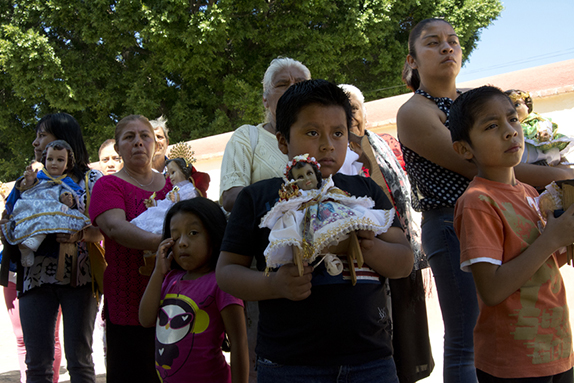
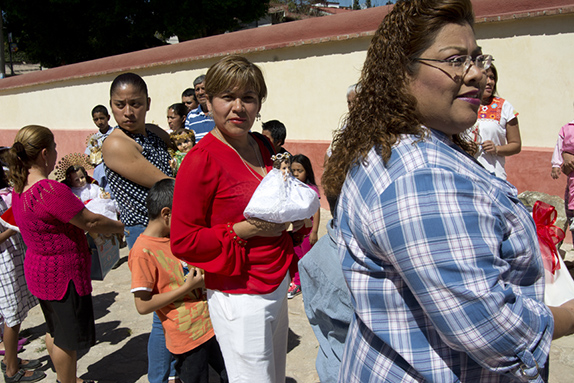
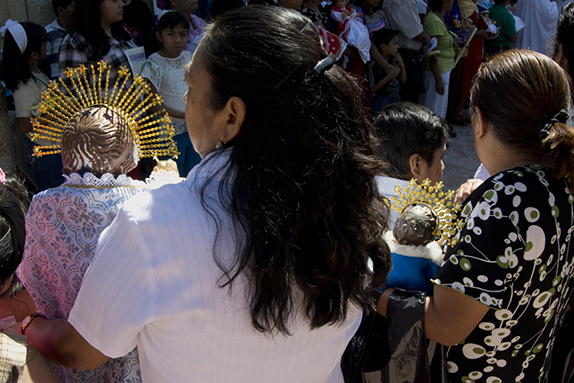
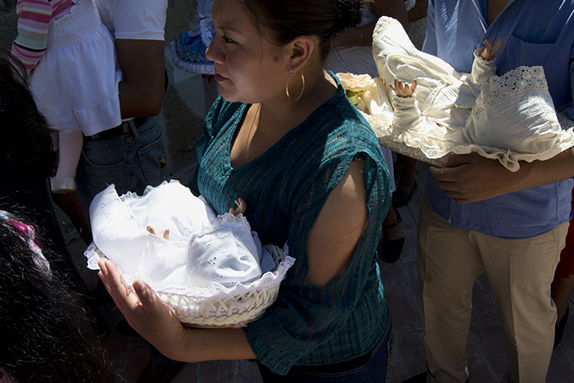
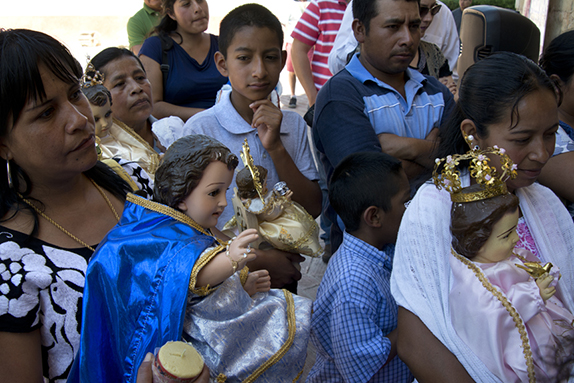
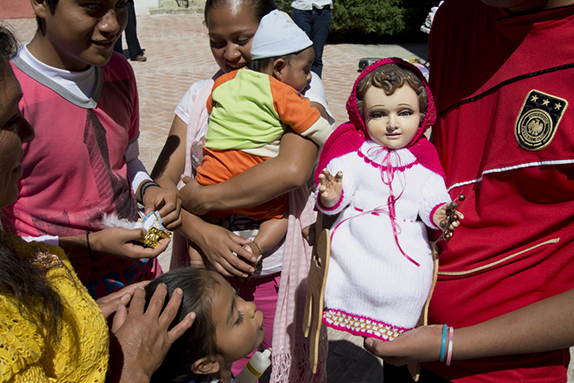
Bendición de la Cruz
The occasion of the blessing was the raising of a roof at a large cross that marks the Barrio de la Cruz section of San Felipe. Passing a turnaround for city buses, one begins to climb, continuing beyond the last house of the neighborhood, then up a very steep dirt lane into the hills. The tuba player stopped to offer me a ride ascending what seemed a lonely stretch of road, but at the top there were lines of chairs already filled with the devoted, here too huddling in the scant shade. More people came trudging sweaty and dusty over the hill, dressed in their Sunday best as if walking in town.
The cross was decorated with flowers, the priest was at the front with his aides. He donned his garb and read about the cross from a book of blessings. A small sign with a “before” photo hung to one side. A repurposed political banner sheltered the cross and the priest. No one had thought to bring the microphone from the church, and anyway there was no electricity, but the police truck had one, so Father Salvador stood inconveniently tethered and had to remember to push the button to talk.
After he spoke, the priest awkwardly instructed the three rows of dignitaries from the neighborhood to stand in a receiving line. As everyone shook hands the event lost formality. The dignitaries then moved into what is really an open-air chapel, with not only a new roof but a cement floor and, today, long tables set up for a feast.
Father Salvador and his team took off in a pickup truck and everyone else stayed to eat and drink. First a small cup of cactus-fruit nieve, or ice, was handed out: brilliant red and welcome cold. Music filled the interim and soon a pickup came up the hill, hauling prepared food in metal basins. Men unloaded them—open despite the dust—and a relay of women began to serve.
Because of the beating sun, a small patch of shade confined us, and I never found a seat. Not being a meat eater, I left as the barbacoa was being served to avoid the impossibility of declining. As I set off down the hill, the mescal began making the rounds, served as it often is from a communal cup.
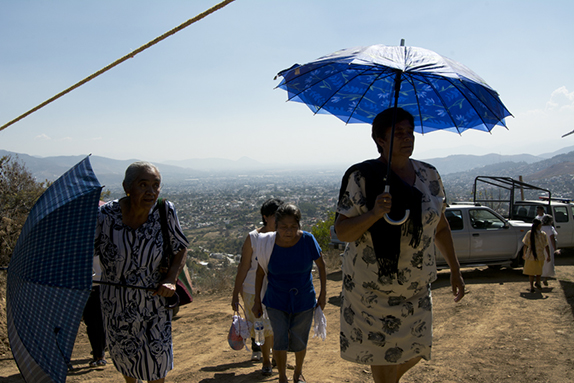
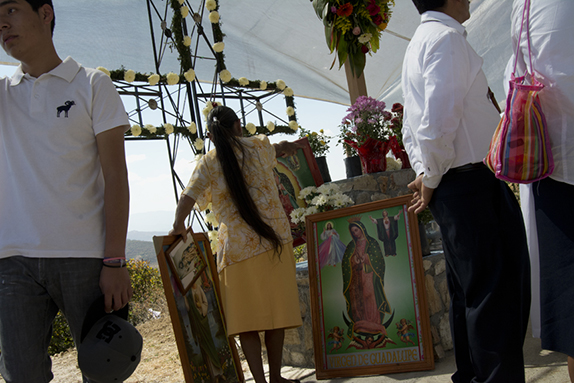
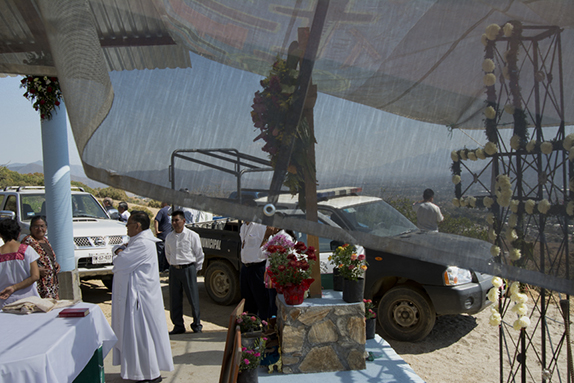
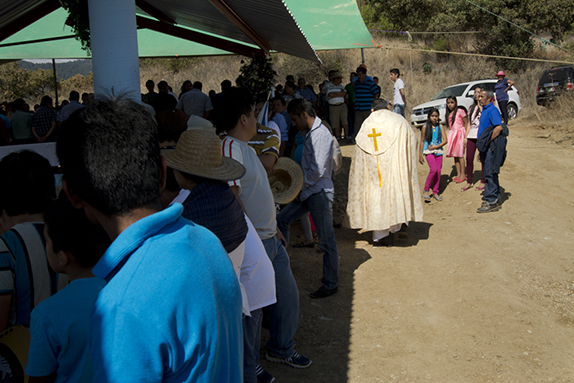
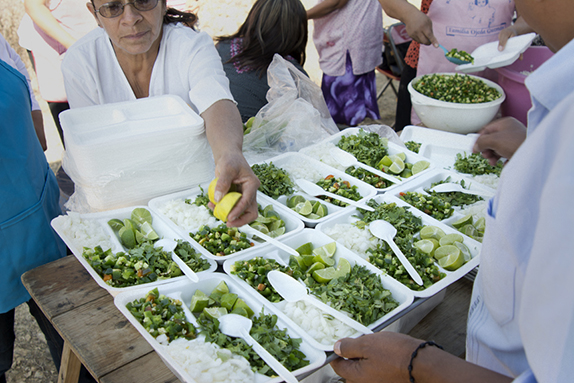
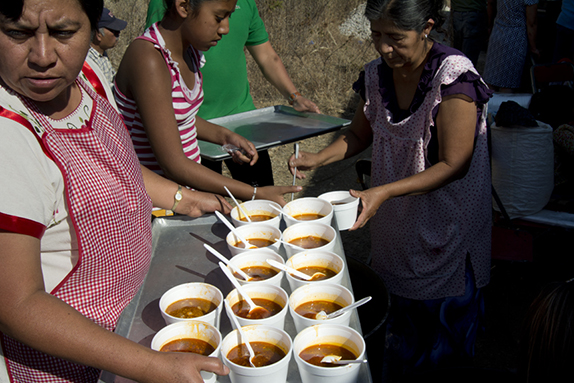
Project Statement: The del agua in “San Felipe del Agua” refers to the fact that a portion of the water from which the colonial Mexican city of Oaxaca lives, flows down from the gem green hills behind what was once a town but now exists as the edge of the larger city: lambs, donkeys, tropical flowers, and a half-hour bus ride to the center of a cosmopolitan metropolis. Those born in San Felipe have a separate set of rights and responsibilities to the community than those who move here. Those who move here tend to bring wealth, and often live behind high walls and drive dark-tinted SUVs.
My family and I lived in Mexico for one year and chose San Felipe because we found a wonderful school there for our children. Having grown up in New Mexico I have always been attracted to Catholic imagery and Guadalupe, growing up atheist I have always been fascinated by faith. And so, in Mexico, I photographed our neighborhood parish.
The photo essays resulting from this study will be published in the New Mexico Mercury from October 2014 through June 2015, roughly once a month on the date corresponding to the event photographed one year previous.

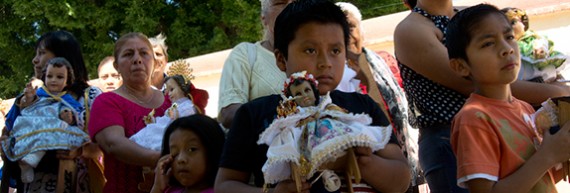
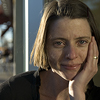

Responses to “La Candelaria y La Bendición de la Cruz”